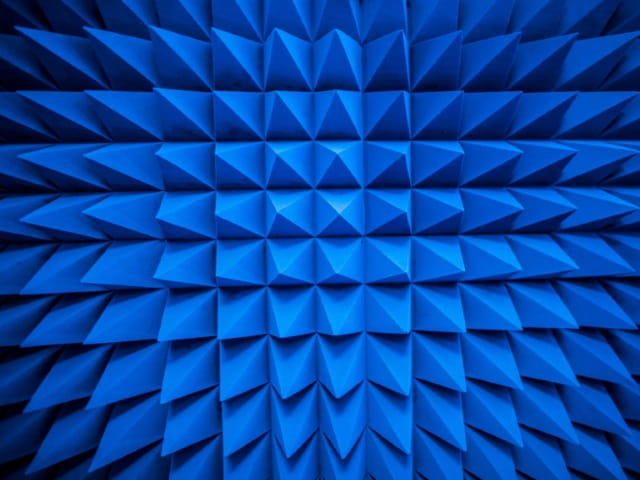Wireless Interference Testing for Medical Devices
Interference to intended communications grows as the number of wireless users increase, which poses a risk to the proper operation of safety-critical devices such as wireless medical devices. Wireless coexistence testing helps to mitigate the risk of interference and provide safe products for patients worldwide.
The use of wireless communications has grown rapidly, so the method of quantifying the risk of interference has historically been varied. In 2007, the Food and Drug Administration (FDA) issued a draft document, “Radio Frequency (RF) Wireless Technology in Medical Devices – Guidance for Industry and FDA Staff,” and followed up with the final document issuance in 2013. Section C: “Considerations for Design, Testing, and Use of Wireless Medical Devices,” outlines the FDA’s current thinking on wireless coexistence and testing recommendations. According to the FDA guidance document:
- Wireless coexistence: the ability of one wireless system to perform a task in a given shared environment where other systems (in that environment) have an ability to perform their tasks and might or might not be using the same set of rules.
Wireless Coexistence Testing Recommendation
The FDA guidance document states: “If the RF wireless medical device is expected to be used in proximity to other RF wireless in-band (i.e., the same or nearby RF frequency) sources, FDA recommends addressing such risks through testing for coexistence of the device wireless system in the presence of the number and type of in-band sources expected to be in proximity to the device. Depending upon the wireless medical device, this should also include multiple units of the subject device operating in the same vicinity, such as when patients are sitting adjacent to one another in a waiting room. Once failure modes and associated risks are identified, we recommend a justification of acceptable risk, or testing or other measures to demonstrate appropriate risk mitigation.”
How We Test Wireless Coexistence for Medical Devices
Our comprehensive approach of testing for wireless coexistence has three parts:
- Determine failure modes and thresholds to wireless communications that occur due to interference: In-band (co-channel and adjacent-channel); Proximity fields from RF wireless communications; Out of band (80-6000 MHz)
- Satisfy IEE/ANSI C63.27-2017, “American National Standard for Evaluation of Wireless Coexistence”, requirements
- Supplement with additional tests as new threats emerge
In-Band Testing
In-band testing determines the signal-to-noise threshold where wireless communications are degraded as well as the threshold where communications stop. The summary of in-band testing provides the necessary data to make a more informed risk analysis of the radio’s behavior and to facilitate the troubleshooting of interference problems reported from the field.
There are two different setups used for in-band testing as shown below.
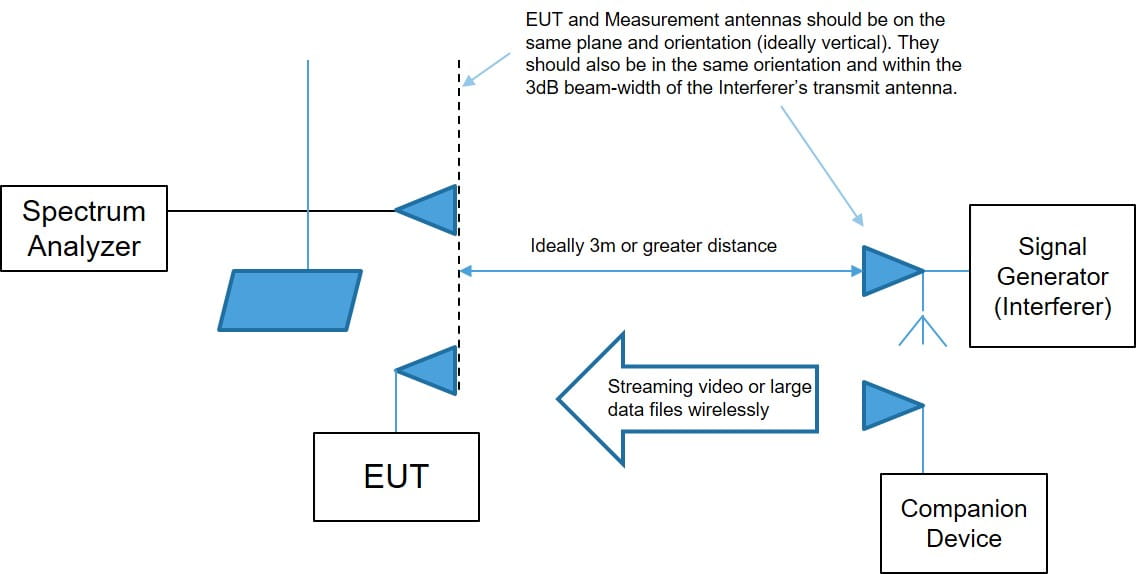
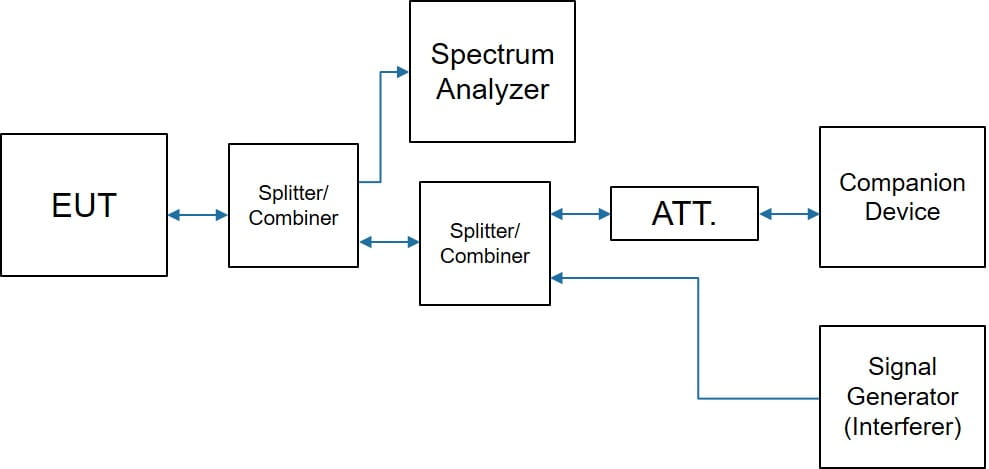
Proximity Fields
The table below is a test summary example provided to clients for minimum separation distances. If the example wireless medical device is to be operated within the proximity of other wireless devices, the following tables may be used to determine the minimum separation distances between the device and nearby transmitters.
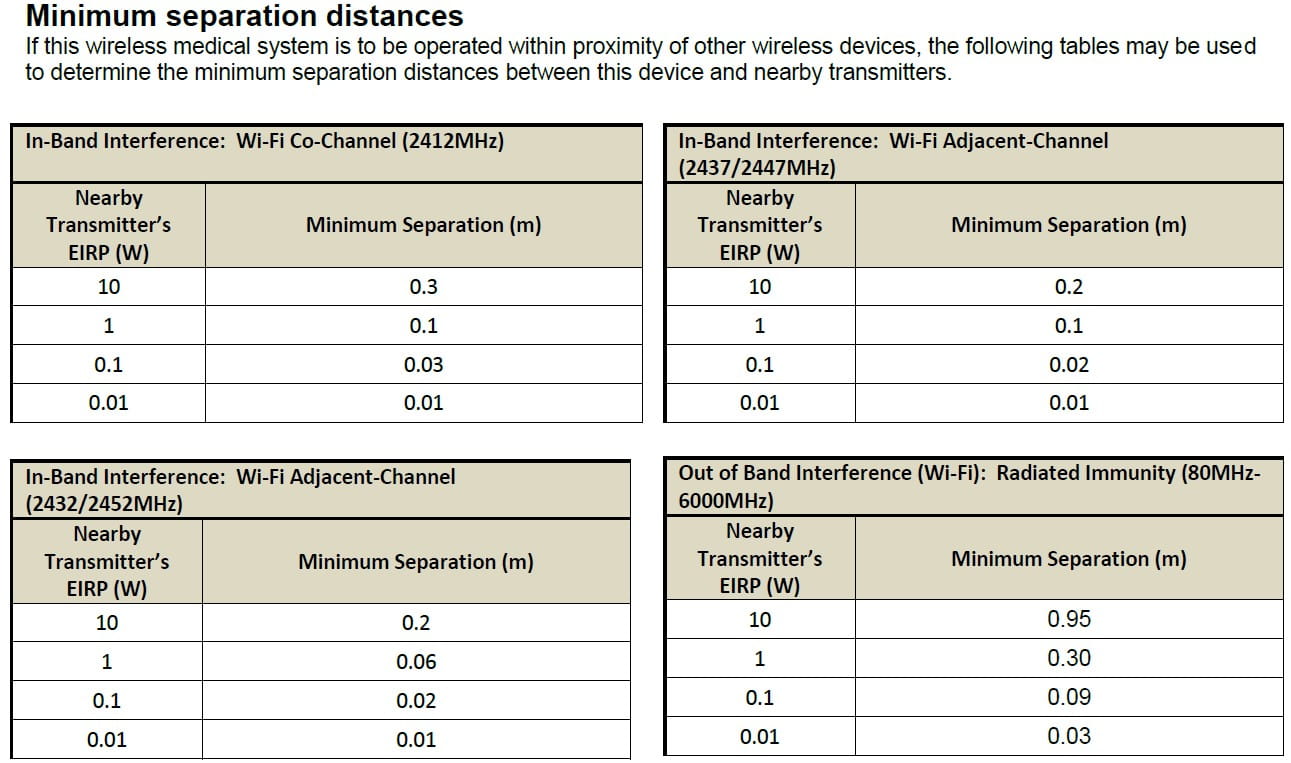
How to Mitigate In-Band Interference
Cognitive radio is the primary mechanism for increasing efficient and effective use of the spectrum. It includes spectrum sensing techniques that facilitate shared use of the spectrum. The most common wireless technologies all make use of cognitive radio: cellular, Wi-Fi and Bluetooth. The threat to effective communications is inherently reduced by implementation of their communication protocols.
Cellular networks have other characteristics that make them typically more robust than Wi-Fi and Bluetooth. Cellular client devices transmit from 200-700 mW compared to less than 100 mW for most unlicensed devices. The higher transmit power provides a greater signal-to-noise ratio.
Additionally, most cellular communications occur with separate transmit and receive channels compared to the transmit and receive functions occurring on the same channel for Wi-Fi. Separate transmit and receive channels reduce the risk of interference from multiple users.
How to Improve Poor Radio Performance
Manufacturers of wireless medical devices have several options for poor radio performance mitigation:
- Shorten the link distance between transceivers. In the case of Wi-Fi radios, this could mean installing more access points. For cellular modems, it could mean selecting a different carrier with more or closer spaced cellular sites or installing a cellular repeater-signal booster on the premises.
- Change frequency bands. For Wi-Fi, there is only one 2.4 GHz frequency band, but there are four 5 GHz bands that are generally much less populated.
- Improve antenna performance. Antenna gain and/or pattern may not be optimized for the intended coverage area. Changing the antenna to either a higher gain antenna or one with a more suitable pattern, can improve communications.
- Improve radio sensitivity. Unintentional intra-system noise may sometimes swamp the radio’s input, thus degrading sensitivity. Noise sources should be identified and, where possible, move away from the radio’s antenna.
IEEE/ANSI C63.27 Compliance
When the standard was published in 2017, we enhanced our testing methodology to ensure compliance. The following additional requirements have been implemented:
Multiple Long-Term Evolution (LTE, a 4G mobile communications standard) and Wi-Fi signals must be simulated for use as interfering signals. We accomplish this with two Vector Signal Generators (VSG) with multiple licenses to generate the required signals.
Very specific guidance for Equipment Under Test (EUT) containing Bluetooth, Wi-Fi, and Digital Enhanced Cordless Telecommunications (DECT) devices.
Three tiers defining the level of evaluation with tier selection based on the consequences of functional wireless performance failure.
The medical device manufacturer must provide a detailed test plan prior to testing.
To develop a robust test plan, device manufacturers need to establish how key performance indicators are determined and monitored and how medical device risk has been evaluated.
Supplemental Testing
Additional tests are occasionally performed such as electronic article surveillance and immunity to radio-frequency identification (RFID) testing.
The proliferation of radio frequency electronic article surveillance anti-theft systems (typically electro-magnetic, acousto-magnetic, radio frequency, microwave or video) is raising concerns for the increasing number of patients with active implants such as cardiac pacemakers due to potential adverse electromagnetic interference. Evaluation of these medical devices is routinely done by exposing them to electronic surveillance systems.
A new RFID immunity standard has been developed by Advancing Identification Matters (AIM), AIM 7351731 “Medical Electrical Equipment & System Electromagnetic Immunity Test for RFID Readers”, to provide guidance on how to evaluate the interaction of devices with RFID systems. Our test methods additionally follow IEC 61999-4-3 and IEC 61000-4-8 where applicable. The key challenge in this test is creating the software to produce the specific modulated signals on a vector signal generator. The signals used are described in Annex A-G of the AIM standard and range from 134.2 kHz to 2.4 GHz.
Conclusion
If wireless medical devices are used in the proximity of other RF wireless sources, wireless coexistence testing may be needed to assess any potential failure modules and associated risks. If it is determined by the manufacturer that medical functionality as implemented by wireless technology does not present a significant risk, the decision may be made to not test for wireless coexistence. However, a manufacturer may still decide to perform testing to assess performance.
As more wireless medical devices enter the product development cycle, wireless coexistence testing is one of the many recommended tests that provides pertinent information for regulatory submissions. If you would like assistance with your device’s wireless coexistence testing, please contact us to discuss how we can help.
Element offers the broadest scope of medical device testing, so if you are looking for additional device testing services such as mechanical testing, package testing, microbiological testing, or accelerated shelf life testing, contact our experts today.
Find related Resources
Related Services
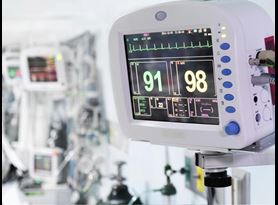
Medical Device Radio Testing
Our medical regulatory affairs experts can identify the appropriate Radio Testing standards and certification, helping to remove both the cost and risk from medical product verification and validation during the formal testing phase.
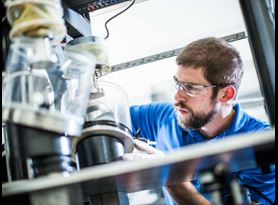
Medical Device Testing
As a comprehensive testing partner, you’ll enjoy the benefit of a single supplier source for all of your testing needs, from mechanical testing and environmental simulation to EMC and wireless device testing.
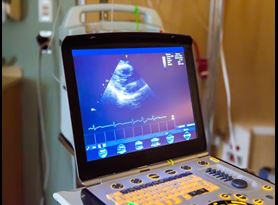
Medical Device Safety Testing
We provide medical device manufacturers with the ability to identify the appropriate safety testing standards and remove both cost and risk out of the product verification and validation process.
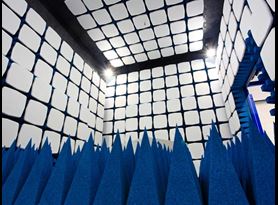
EMC Testing Services
Find out about Element's comprehensive range of EMC service and testing capabilities in the USA, UK, and Germany.
